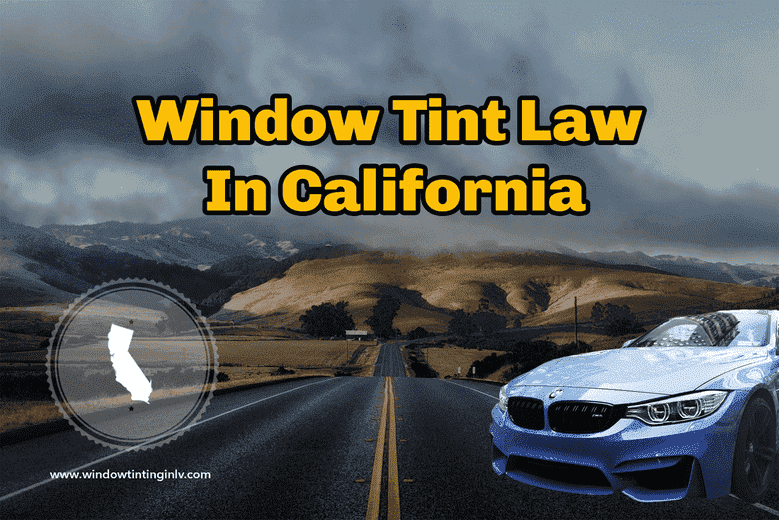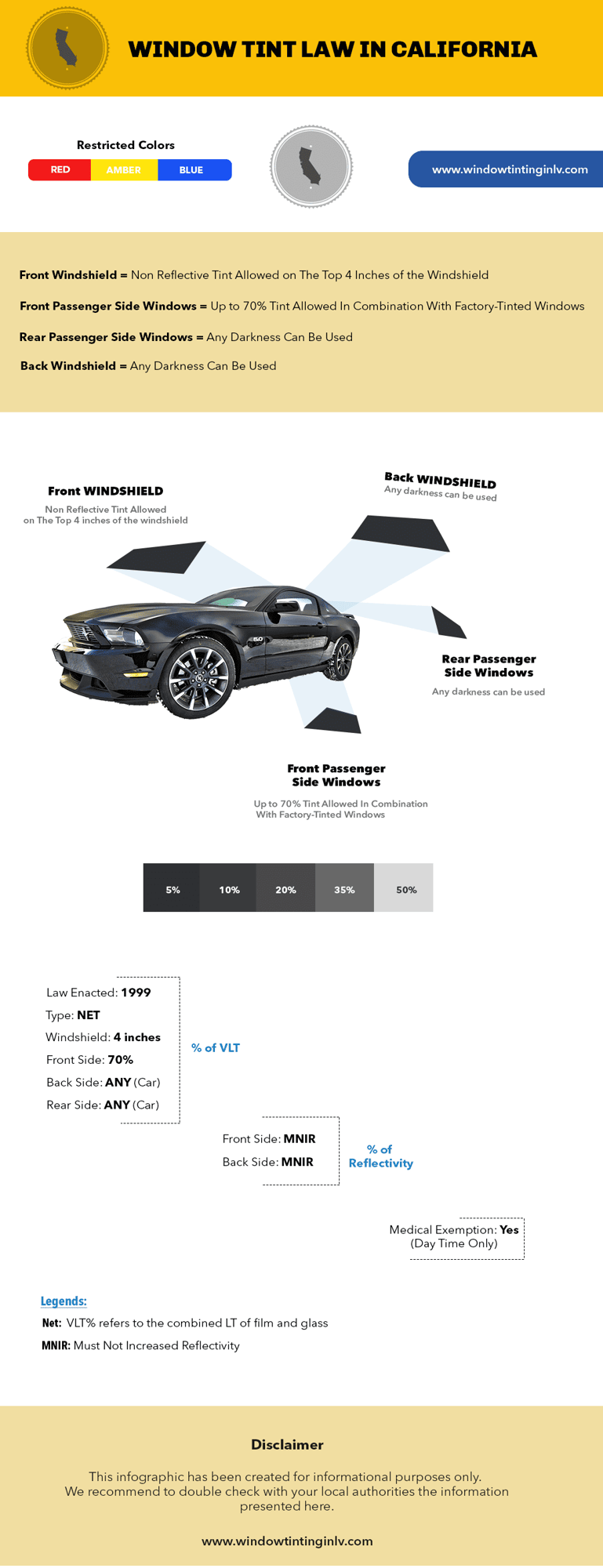
Disclaimer: As an Amazon Associate I earn from qualifying purchases.
If you plan to upgrade your car, you have to be very cautious since various states have certain limits, especially how far you can go when tinting your windows.
For your information, here you can take a look at what California Window tint law says.
For 2024 the law requires that a reflected tint is not allowed on the first 4 inches of the windshield and front side windows and up to 70% of tint darkness is allowed in combination with factory-tinted windows. For the rear windows and back seat side windows, any tint darkness can be used.
Bear in mind though, that if the rear window is tinted, it is required to have dual side mirrors.
These rules apply to all types of vehicles.
Whether you own a sedan, SUV, truck, or van, you must follow and respect the law to not encounter any issues when pulled over by the police.
Car customization is one of the exciting tasks for car enthusiasts.
They appreciate adjusting their vehicles, and quite possibly the most notable change is to tint the windows.
Tinting your car windows helps shield you from the sun’s beams, and it may also give your vehicle an exceptionally classy look among many other great benefits.
In this article, we are going to have some insight into the Window tint law in California.
It is simple if you want to tint your car windows, you must know the rules and the regulations of your state regarding this particular matter.
The law also allows a specific reflection of the window, so you have to be very careful if you don’t want to be pulled over by the police whenever they see you.
- A non-reflective tint is allowed on the first 4 inches of the windshield and front side windows
- Up to 70% of tint darkness is allowed in combination with factory-tinted windows.
- For the rear windows and back seat side windows, any tint darkness can be used.

- Knowing the right VLT is mandatory
The percentage of light that a window tint film permits to go through your vehicle windows is known as the VLT (Visible Light Transmission), and every state has distinctive legal limitations.
How much light is allowed to pass through your tinted glass in California particularly varies from state to state and also is distinctive from passenger vehicles and multi-purpose vehicles.
- Regulations for Front Windshield
Usually, the front windshield is prohibited because the driver has to have a clear view of the road.
But the top 4 inches of the area, which is sometimes called “eyebrow,” is allowed with the non-reflective strip.
- Front Passenger Windows
The only VLT rating allowed by the law for tinting the front passenger windows is below 88%.
Nevertheless, the allowed percentage is 70% with the condition that you combine the aftermarket film with the factory-tinted windows.
- No Restrictions on the Backside and rear Windows
Since Backside windows and rear windows have nothing to do with the driver, you can tint them as dark as you want. No limits at all.
- Dual Side Mirrors
A dual-side mirror on your vehicle is required if your rear window is tinted. It is a legal requirement since it allows the driver to see the road behind the vehicle.
- Color Restrictions
There are some legal limitations concerning the color of the tints as well.
In short, you cannot use blue, amber, or red as your window tint.
You can use any other colors, though.
Also, you are not legally permitted to have any colored tint on your side windows.
Therefore, it is better to avoid such tints.
- Window Tint Certification rules
The certification is mandatory from the manufacturers of the tint films from the state.
The address and the name must be seen on the certificate.
Drivers must be able to present the certificate when asked, therefore it is wise to keep it with them at all times.
- Certified sticker from the Company
Apart from the certificate, you must have the sticker from the tint manufacturer with the name and the address visible on that sticker as the state law requires that too, otherwise you will be pulled over by the cops anytime you are out with your vehicle.
- Medical Exemptions in California
California permits exemptions for these laws for individuals with great clinical necessities.
These laws have been in power since September 2017, and explanations behind this may incorporate conditions, for example, lupus, daylight sensitivity, photosensitivity, and melanoma.
As required by the exemption law, the driver of a vehicle with darker tinted windows must have the document issued by the window tint installer but also a clinical note from the specialist in dermatology providing details of the special needs.
Why Do We Need These Laws?
There is always particular reasoning and research behind every law.
Similarly, there is something behind how dark you can tint your windows.
This law exists in many states in the US.
Reasonably, the first and most evident explanation is that dark-tinted windows can hinder the driver’s field of vision.
It is one of the most apparent reasons; significantly, a driver has a crystal clear view of what is going on around him.
However, the dark tinted windows obstruct his vision in the traffic.
In short, a tinted windshield or front side windows can fundamentally weaken the driver’s vision and can cause major accidents.
This is particularly evident in evening time since tinted windows wouldn’t permit the light from other vehicle’s headlights and taillights to go through the windows, making it a lot harder to see them.
This way, the chances of accidents get higher.
Moreover, the tinted windows don’t permit traffic cops to perceive what is happening in the vehicle.
If by chance they stop somebody for a standard speeding infringement or other minor encroachment, they must have to see inside the car for security reasons.
Words of Wisdom
If you want to enjoy a safe and trouble-free drive, you have to follow the rules and regulations implemented by the state.
Whether you like it or not, this is for your safety and the safety of others.
In any case, you must be well aware of the relevant window tint law of California and make sure you are not breaking any of the rules with your tinted windows.
Moreover, to avoid further inconvenience, you may simply remove your tint film.
This action will avoid the hassle of being pulled over by the cops every other day.
FAQ
Is 35% tint legal in California?
Due to strict California’s tinting laws, the 35% tint is illegal.
The only way to get a 35% tint on your vehicle is by having a specific disease that requires you a darker tint.
This has to be obtained from a specialist and must be written that it is recommended because of one’s disease and this permit has to be kept with you at all times to be able to demonstrate your exemption from the regular rules.
Can you get pulled over for tinted windows in California?
Knowing that the legal tint percentage allowed in California is 70% and the fact that other laws must be kept too, if you do not comply and violate the state regulations, you may be pulled over and get fined and you will probably also be required to remove your vehicle tint.
Is 20% tint illegal in California?
Yes, that is illegal. The only percentage allowed is 70% if that is combined with factory-tinted windows.
How much is a ticket for tinted windows in California?
It depends. If you receive only a fine – that is of a value of $25 according to Vehicle Code 26708 and you will need to remove the tinted windows. However, if you get charged with an infraction too, the fine is $197.
What tint can you get away with in California?
For the rear window and the back side windows, you can use whatever tint darkness you prefer.
However, for the front driver and passenger window, the tint percentage allowed is 70% if combined with factory-tinted windows.
What is the darkest legal tint allowed in California?
If you do not wish to get into unnecessary issues when encountering police traffic control, then by having 70% tinted windows you are legally respecting the statutes.
For the backside and rear window, you may use whatever level of darkness you would like.
Disclaimer
The information presented in this article is not intended to substitute legal advice nor is intended as legal advice.
Because laws are continually subject to changes, we encourage you to verify every information presented here with your local authorities or a traffic lawyer.
Thank you for your understanding and if you would like to add or spot anything wrong or misleading, please contact us.
References
California Vehicle Code – Division 12 – Equipment of Vehicles, Chapter 4 – Windshields and Mirrors
State Window Tinting Rules and Laws (USA)
Medical Exemption – Assembly Bill No. 1303 Chapter 210
State of California Info
California is a state located on the West Coast of the United States. It is the most populous US State, home to 1 out of 8 Americans, and is the third-largest state by area (after Alaska and Texas). It is home to the nation’s second and fifth-largest census statistical areas (Greater Los Angeles Area and San Francisco Bay Area, respectively), and eight of the nation’s 50 most populated cities (Los Angeles, San Diego, San Jose, San Francisco, Fresno, Sacramento, Long Beach, and Oakland). The capital city is Sacramento.
Population: 39.51M
Area: 163,696 square miles
Main Cities: Alameda, Alpine, Amador, Butte, Calaveras, Colusa, Contra Costa, Del Norte, El Dorado, Fresno, Glenn, Humboldt, Imperial, Inyo, Kern, Kings, Lake, Lassen, Los Angeles, Madera, Marin, Mariposa, Mendocino, Merced, Modoc, Mono, Monterey, Napa, Nevada, Orange, Placer, Plumas, Riverside, Sacramento, Hollister, San Bernardino, San Diego, San Francisco, San Joaquin, San Luis Obispo, San Mateo, Santa Barbara, Santa Clara, Santa Cruz, Shasta, Sierra, Siskiyou, Solano, Sonoma, Stanislaus, Sutter, Tehama, Trinity, Tulare, Tuolumne, Ventura, Yolo, Yuba
Main Counties: Los Angeles, San Francisco, San Diego, Sacramento, San Jose, Oakland, Santa Barbara, Mountain View, Pasadena, Anaheim, Beverly Hills, Berkeley, Monterey, Long Beach, Palm Springs, Santa Monica, San Benito, Malibu, Fresno, Bakersfield, Palo Alto, Big Sur, Calabasas, Irvine, Newport Beach, Cupertino, Huntington Beach, Napa, Temecula, Modesto, Torrance, Santa Cruz, Laguna Beach, San Luis Obispo, Riverside, Sunnyvale, Stockton, Pleasanton, Ontario, Ventura, Fremont, Menlo Park, Orange, Carmel-by-the-Sea, Carlsbad, Burbank, Santa Rosa, Solvang, Eureka
Official State Website: https://www.ca.gov/
Also check Best Car Window Tint
Check Out Other States Window Tint Laws:
Window Tint Law In Virginia
Texas Window Tint Laws
Nevada Window tinting Laws
Window Tint Laws in Florida
Window Tint Laws in Ohio
North Carolina Window Tint Laws
Pennsylvania Tint Laws
Window Tint Law In Illinois
Window tint Law In Georgia
Michigan Window tint Laws